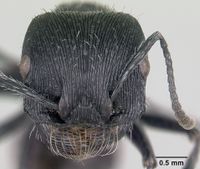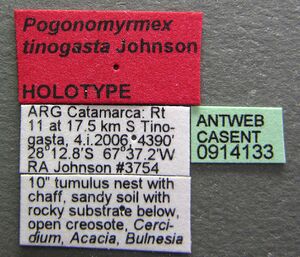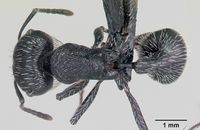Pogonomyrmex tinogasta
| Pogonomyrmex tinogasta | |
|---|---|

| |
| Scientific classification | |
| Kingdom: | Animalia |
| Phylum: | Arthropoda |
| Class: | Insecta |
| Order: | Hymenoptera |
| Family: | Formicidae |
| Subfamily: | Myrmicinae |
| Tribe: | Pogonomyrmecini |
| Genus: | Pogonomyrmex |
| Species group: | laticeps |
| Species: | P. tinogasta |
| Binomial name | |
| Pogonomyrmex tinogasta Johnson, 2015 | |
A seed harvesting ant that appears to be restricted to the central portions of the High Monte Desert ecoregion.
Identification
Johnson (2015) - Worker Within the P. laticeps-group, the combination of: (1) body concolorous black except for dark reddish band encircling eye, (2) rugae on promesonotum longitudinal, usually regular, and (3) medial rugae along posterior margin of head longitudinal, rarely rugoreticulate uniquely characterize this species.
Dealate (brachypterous) queen This caste is diagnosed by: (1) brachypterous with ocelli on head, (2) in dorsal view, mesoscutum poorly-developed, anterior margin barely surpassing humeral shoulders of pronotum, (3) pronotum well-developed, (4) in profile, the pronotum rises at an approximately 45° angle to meet the mesoscutum, and (5) body concolorous black, often with lighter reddish-black band that encircles eyes.
Pogonomyrmex tinogasta is not known to co-occur with Pogonomyrmex laticeps or Pogonomyrmex mendozanus. Pogonomyrmex tinogasta can be distinguished from P. mendozanus by the coarse, irregular rugae on the head and mesosoma, whereas rugae on the head and mesosoma of P. mendozanus are fine, incised, and very regular. Pogonomyrmex tinogasta can be distinguished from P. laticeps based on the following characters: (1) body concolorous black except for dark reddish band encircling eye, (2) promesonotal rugae longitudinal, usually regular, and (3) medial rugae along posterior margin of head longitudinal, rarely rugoreticulate. In P. laticeps: (1) the head and mesosoma are dark reddish-black, gaster black, (2) rugae on the promesonotum are transverse, oblique, or irregular, rarely longitudinal, and (3) medial rugae along the posterior margin of the head are usually partly rugoreticulate.
Keys including this Species
- Key to Pogonomyrmex queens of South American
- Key to Pogonomyrmex workers of South American
- Pogonomyrmex de Sur America clave a las obreras
- Pogonomyrmex de Sur America clave a las reinas
Distribution
Distribution based on Regional Taxon Lists
Neotropical Region: Argentina (type locality).
Distribution based on AntMaps
Distribution based on AntWeb specimens
Check data from AntWeb
Countries Occupied
| Number of countries occupied by this species based on AntWiki Regional Taxon Lists. In general, fewer countries occupied indicates a narrower range, while more countries indicates a more widespread species. |

|
Estimated Abundance
| Relative abundance based on number of AntMaps records per species (this species within the purple bar). Fewer records (to the left) indicates a less abundant/encountered species while more records (to the right) indicates more abundant/encountered species. |

|
Habitat
Pogonomyrmex tinogasta inhabits sites at elevations from 1100–1330 m. This species is restricted to central portions of the High Monte Desert ecoregion as defined by Olson et al. (2001), and it is only known from the Tinogasta Department of Catamarca Province. Nests are located in sand dunes and sandy soils with a rocky substrate in the Monte Desert woodland with dominant plant species including Larrea sp., Parkinsonia spp., Prosopis spp., Bulnesia sp., and Acacia sp.
Biology
Johnson (2015) - Pogonomyrmex tinogasta is a solitary forager that harvests the seeds of various species. Most nests have an external seed chaff midden, the contents of which suggest that grass seeds are one of the primary items harvested. Nests have a tumulus that ranges from 15–25 cm in diameter. Colonies of P. tinogasta probably contain 300–500 workers.
Nothing is known about the reproductive biology of P. tinogasta, but the queens are unusual. Several dealate queens of P. tinogasta were collected near the surface of a nest excavated on 5 January, and several additional queens were collected foraging outside the nest. Several ant species have queens that apparently sometimes forego mating and later perform tasks such as foraging and nest maintenance (Peeters, 1997), and this behavior also appears to occur in P. tinogasta. Reproductive status was not determined for these queens, but they are assumed to have been unmated given that foraging queens (both ergatoid and dealate) are unmated in P. pima, which is the only species in which such queens have been dissected (Johnson et al., 2007). These observations add another Pogonomymex to the list of species in which queens forage outside the nest (Johnson et al., 2007).
All queens collected by the author were dealate, but close examination of morphology suggested that these queens were brachypterous—these morphological features included: (1) faint ocelli, (2) enlarged pronotum and much reduced mesoscutum, and (3) the slope at which the pronotum raises to meet the mesoscutum is less steep; it is fully vertical in normal alate queens, while it rises at an approximately 45° angle in brachypterous queens and ergatoid queens. That these queens were brachypterous was verified via dissections in which one queen was found to lack direct flight muscles and any trace of internal phragmata; the latter are cuticular projections present in all flying insects that function to support the longitudinal wing muscles.
Castes
Images from AntWeb
   
| |
| Paratype of Pogonomyrmex tinogasta. Worker. Specimen code casent0235286. Photographer Will Ericson, uploaded by California Academy of Sciences. | Owned by MACN, Buenos Aires, Argentina. |
   
| |
| Queen (alate/dealate). Specimen code casent0235287. Photographer Will Ericson, uploaded by California Academy of Sciences. | Owned by RAJC, Robert A. Johnson Collection. |
   
| |
| Paratype of Pogonomyrmex tinogasta. Worker. Specimen code casent0281107. Photographer Shannon Hartman, uploaded by California Academy of Sciences. | Owned by RAJC, Robert A. Johnson Collection. |
   
| |
| Holotype of Pogonomyrmex tinogasta. Worker. Specimen code casent0914133. Photographer Michele Esposito, uploaded by California Academy of Sciences. | Owned by MACN, Buenos Aires, Argentina. |
Males have yet to be collected.
Nomenclature
The following information is derived from Barry Bolton's Online Catalogue of the Ants of the World.
- tinogasta. Pogonomyrmex tinogasta Johnson, 2015: 94, figs 47-48 (w.q.) ARGENTINA.
Unless otherwise noted the text for the remainder of this section is reported from the publication that includes the original description.
Description
Worker
Holotype (n = 13 paratypes). HL 1.87 (1.74–2.02); HW 1.98 (1.79–2.23); MOD 0.40 (0.36–0.45); OMD 0.51 (0.45–0.58); SL 1.45 (1.33–1.57); PNW 1.24 (1.12–1.39); HFL 2.03 (1.90–2.13); ML 2.12 (2.16–2.60); PW 0.50 (0.48–0.57); PPW 0.74 (0.69–0.84). Indices: SI 73.23 (62.44–76.54); CI 105.88 (102.87–113.78); OI 20.20 (18.18–22.35); HFI 102.53 (92.66–107.58).
Head subquadrate to wider than long (CI = 102.87–113.78), widest just posterior to eye; posterior margin flat in full-face view. Longitudinal rugae on cephalic dorsum prominent, weakly wavy to irregular; in full-face view, medial rugae diverging weakly toward posterior corners of head. In profile, rugae posterior to eyes converging toward vertex; vertex rugose. Cephalic interrugae weakly to moderately granulate-punctate, weakly shining to shining. Anterior margin of clypeus flat to weakly concave; dorsal surface with numerous subparallel, longitudinal rugae. Mandible with six teeth; mandibular dorsum coarsely rugose. Numerous long, curved, bristle-like, yellowish to brownish hairs project from anterior margin of clypeus and basolateral margin of mandibles. MOD ranging from 0.19–0.24x HL. In profile, eyes situated near middle of head, OMD = 1.09–1.39x MOD. Antennal scapes relatively long (SI = 62.44–76.54), failing to reach vertex by up to length of basal funicular segment, smooth and shining, distal portion often weakly striate. Basal flange of scape flattened, well-developed with carinate margin. Psammophore well-developed.
Mesosomal profile flat to weakly convex; all mesosomal surfaces with prominent rugae. In profile and dorsal views, humeral shoulders of pronotum angulate, occasionally weakly elevated above medial portion of pronotum. Dorsum of promesonotum with wavy to irregular longitudinal rugae that diverge anterad toward humeral shoulders of pronotum, occasionally weakly rugoreticulate or irregularly transverse; anterior margin of pronotum with wavy to irregular transverse rugae that traverse ventrally on pronotal sides. Mesopleura with wavy to irregular rugae angling posterodorsally, rugae often more irregular to rugoreticulate near anterodorsal margin. Posterior surface of propodeum with transverse to weakly irregular rugae that traverse anteroventrally on sides. Propodeum with long, acuminate spines connected by well-defined keel; spines longer than distance between their bases. Inferior propodeal spines absent or reduced to indistinct broadly rounded processes. Propodeal spiracles narrowly ovate facing posterad. Interrugae on mesosoma weakly to moderately punctate to coriarious, weakly shining. Legs moderately coriarious, weakly shining.
Peduncle of petiole slightly shorter than petiolar node, anteroventral margin with bluntly angulate tooth-like process. In profile, petiolar node asymmetrical with anterior surface shorter than posterior surface; apex weakly angulate to rounded. In dorsal view, petiolar node longer than wide, sides subparallel to slightly wider near spatulate anterior margin; posterior surface and sides with moderately strong, wavy to irregular, transverse to arcuate rugae. Dorsum of postpetiole convex in profile; in dorsal view, widest near posterior margin, narrowing toward anterior margin; maximal width about equal to length; dorsum and sides with wavy to irregular transverse rugae that are finer, denser than those on posterior surface of petiolar node. Interrugae weakly coriarious, weakly shining on posterior surface of petiolar node, weakly to moderately coriarious, dull to weakly shining on dorsum of postpetiole. First gastral tergum weakly to moderately coriarious, weakly shining to shining.
Erect whitish pilosity moderately abundant on head, variable in length, longest hairs shorter than MOD. Moderately abundant suberect to semidecumbent pilosity on scape, abundant decumbent hairs on funicular segments. Legs with moderately abundant semidecumbent white setae. Mesosoma, petiolar node, postpetiole, gastral terga with moderately dense, erect setae, mostly similar in length, only those on posterior gastral terga approaching MOD. Body concolorous black, often with dark reddish to brownish hue except for dark reddish-black band that usually encircles eyes.
Queen
(n = 12). HL 2.19–2.38; HW 2.44–2.64; MOD 0.47–.59; OMD 0.57–0.61; SL 1.55–1.73; PNW 1.56–1.65; HFL 2.20–2.41; ML 2.68–3.02; PW 0.60–0.67; PPW 0.97–1.09. Indices: SI 61.00–68.03; CI 105.96–117.65; OI 18.43–22.78; HFI 84.94–96.72.
Brachypterous, with caste-specific morphology of the mesosoma related to wing-bearing and presence of small ocelli on head. In full-face view, head wider than long (CI = 105.96–117.65), posterior margin weakly concave medially. Longitudinal rugae on cephalic dorsum prominent, weakly wavy; in full-face view, medial rugae diverging weakly toward posterior corners of head, interrugae weakly coriarious, weakly shining to smooth and shining; vertex rugose, interrugae smooth, shining. Mandible with six teeth, dorsal surface coarsely rugose. Psammophore well-developed.
All mesosomal surfaces with subparallel, regular to wavy rugae; interrugae weakly coriarious, weakly shining to smooth and shining. In profile, the pronotum rises at an approximately 45° angle to meet the mesoscutum. Superior propodeal spines short to medium-length; inferior spines absent to very poorly-developed. Peduncle of petiole about 0.8x as long as petiolar node, anteroventral margin with acute triangular process. In profile, petiolar node asymmetrical with anterior surface notably shorter than posterior surface, apex weakly angulate to rounded. Postpetiole wider than long. Posterior surface of petiolar node with transverse or oblique, regular to irregular rugae; dorsum of postpetiole with weaker, denser, transverse rugae; interrugae on posterior surface of petiolar node and dorsum of postpetiole weakly coriarious, weakly shining to smooth and shining. Gastral terga weakly coriarious, shining. Most body surfaces with moderately abundant suberect to erect, short to medium-length white setae. Body concolorous black, often with reddish tinge except for lighter reddish-black band that encircles eyes.
Type Material
Holotype worker [CASENT0914113]: ARGENTINA, Catamarca: Departamento Tinogasta, Ruta 11 at 17.5 km south of Tinogasta, 28o12.8’S 67o37.2’W, 4390 feet (1330 m), 4 January 2006 (R.A. Johnson #3754) [MACN]. Paratypes, same data as holotype: FML (3w), MACN (9w), RAJC (9w), UCDC (3w). Additional paratype series from the same locality and date—RAJ #3753: CASC (1w), FML (3w), MACN (9w), LACM (3w), MCZ (3w), RAJC (9w), USNM (3w); RAJ #3755: MACN (9w), RAJC (9w).
Etymology
The specific epithet, tinogasta, is a noun in apposition and invariant in form. The name is derived from a small, localized group of Native Americans that lived in a pueblo of the same name.
References
- Johnson, R.A. 2015. A taxonomic revision of South American species of the seed-harvester ant genus Pogonomyrmex (Hymenoptera: Formicidae). Part I. Zootaxa 4029:1–142 (doi:10.11646/zootaxa.4029.1.1).
- Johnson, R.A. 2021. A taxonomic revision of South American species of the seed-harvester ant genus Pogonomyrmex (Hymenoptera: Formicidae). Part II. Zootaxa 5033, 1–230 (doi:10.11646/zootaxa.5033.1.1).
References based on Global Ant Biodiversity Informatics
- Johnson R. A. 2015. A taxonomic revision of South American species of the seed-harvester ant genus Pogonomyrmex (Hymenoptera: Formicidae). Part I. Zootaxa 4029(1):1-142

